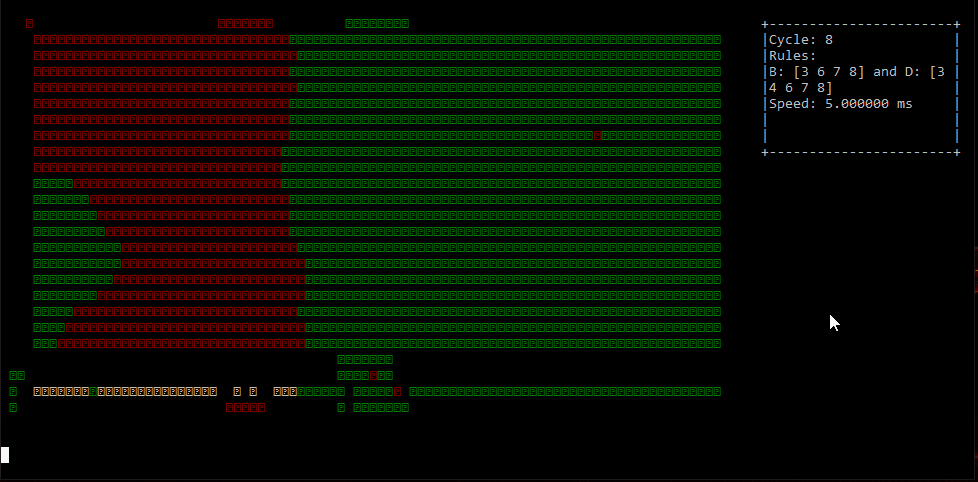A cellular automaton game engine that can run many Cellular automaton 'Life' games including 'Conway's Game of Life' in honour of John Horton Conway. Can also do other life rules via user input. Makes use of the awesome 'termui' (https://github.com/gizak/termui) library for the graphics.
-
(sourced from https://en.wikipedia.org/wiki/Life-like_cellular_automaton) There are 218 = 262,144 possible Life-like rules, only a small fraction of which have been studied in any detail. In the descriptions below, all rules are specified in Golly/RLE format.
Notable Life-like rules to explore:
- B1357/S1357 Replicator Edward Fredkin's replicating automaton: every pattern is eventually replaced by multiple copies of itself.[2][3][4]
- B2/S Seeds All patterns are phoenixes, meaning that every live cell immediately dies, and many patterns lead to explosive chaotic growth. However, some engineered patterns with complex behavior are known.[2][5][6]
- B25/S4 This rule supports a small self-replicating pattern which, when combined with a small glider pattern, causes the glider to bounce back and forth in a pseudorandom walk.[4][7]
- B3/S012345678 Life without Death Also known as Inkspot or Flakes. Cells that become alive never die. It combines chaotic growth with more structured ladder-like patterns that can be used to simulate arbitrary Boolean circuits.[2][4][8][9]
- B3/S23 Life Highly complex behavior.[10][11] (Game of Life rules)
- B34/S34 34 Life Was initially thought to be a stable alternative to Life, until computer simulation found that larger patterns tend to explode. Has many small oscillators and spaceships.[2][12][13]
- B35678/S5678 Diamoeba Forms large diamonds with chaotically fluctuating boundaries. First studied by Dean Hickerson, who in 1993 offered a $50 prize to find a pattern that fills space with live cells; the prize was won in 1999 by David Bell.[2][4][14]
- B36/S125 2x2 If a pattern is composed of 2x2 blocks, it will continue to evolve in the same form; grouping these blocks into larger powers of two leads to the same behavior, but slower. Has complex oscillators of high periods as well as a small glider.[2][15]
- B36/S23 HighLife Similar to Life but with a small self-replicating pattern.[2][4][16]
- B3678/S34678 Day & Night Symmetric under on-off reversal. Has engineered patterns with highly complex behavior.[2][4][17]
- B368/S245 Morley Named after Stephen Morley; also called Move. Supports very high-period and slow spaceships.[2][4][18]
- B4678/S35678 Anneal Also called the twisted majority rule. Symmetric under on-off reversal. Approximates the curve-shortening flow on the boundaries between live and dead cells.[19][20][21]
-more info here http://www.mirekw.com/ca/rullex_life.html
What i plan to do next:
- Add a higher res GUI! I've managed to bungle in the canvas from termui but i'm sure there's probably a better way as termui is meant for command line GUI's.
- Refactor the code so it makes more sense
